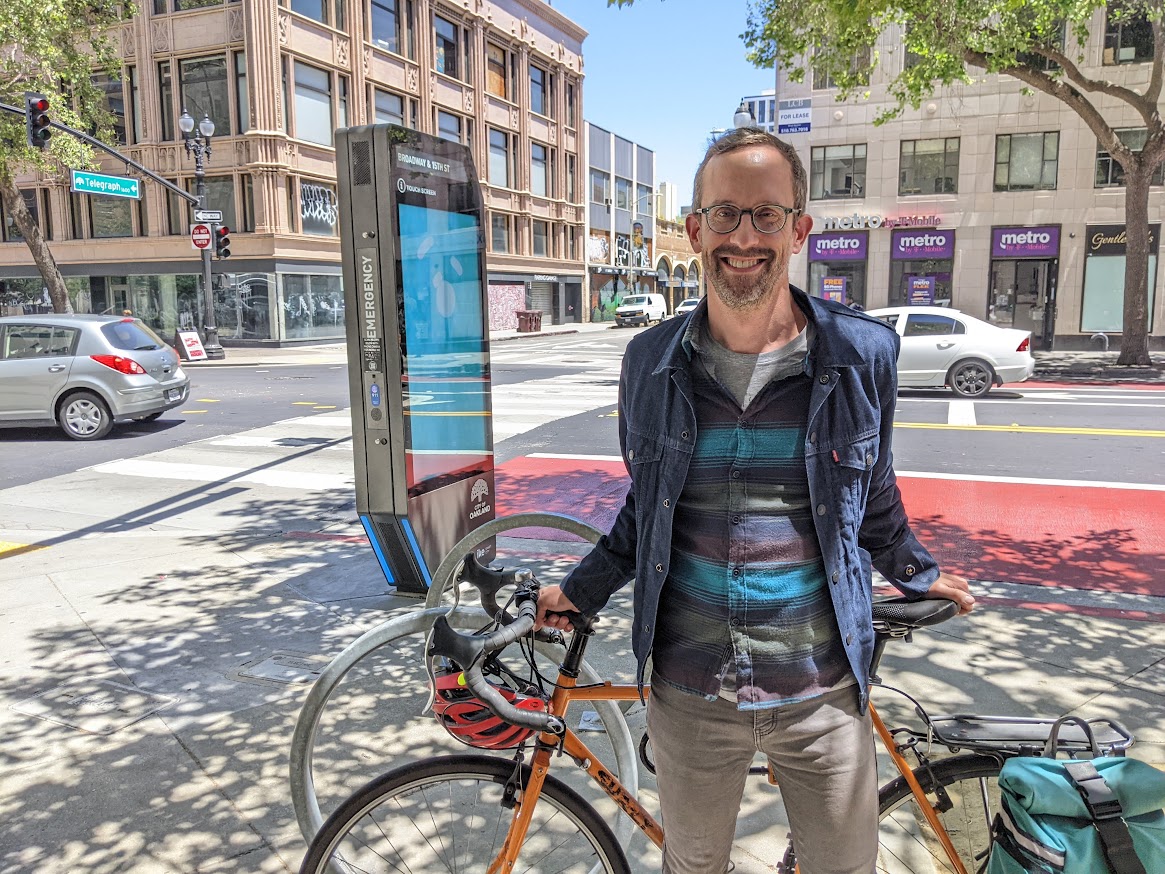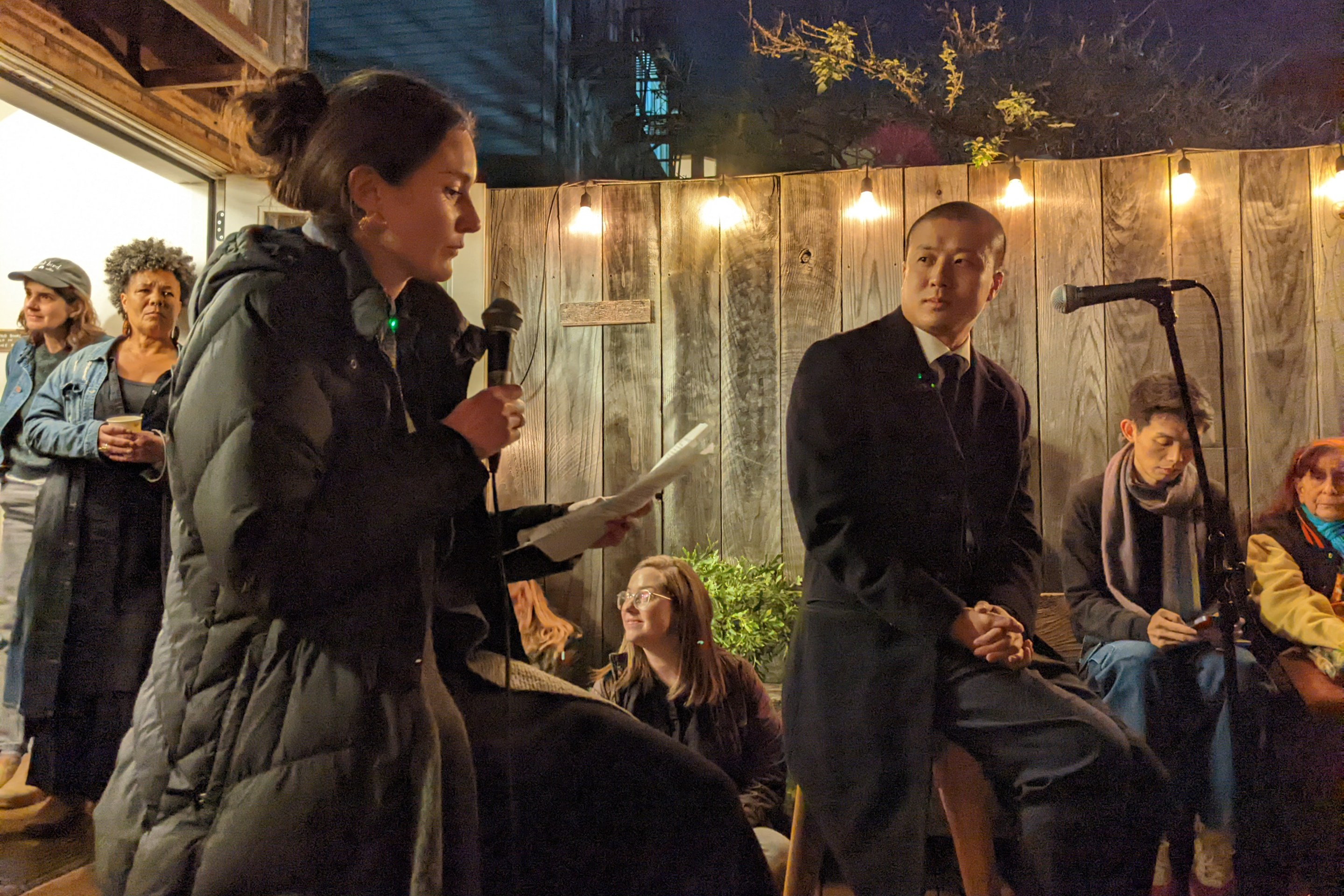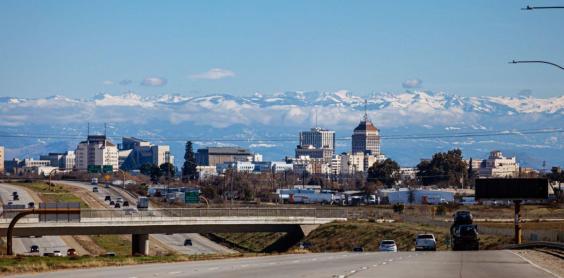Note: GJEL Accident Attorneys regularly sponsors coverage on Streetsblog San Francisco and Streetsblog California. Unless noted in the story, GJEL Accident Attorneys is not consulted for the content or editorial direction of the sponsored content.
Christopher White was named as the San Francisco Bicycle Coalition's new executive director almost a week ago. The appointment wasn't a huge surprise, as the long-time staffer had been serving as interim director for several months. White joined the organization in 2017 as coordinator for adult bicycle education. Before getting into bicycle advocacy, he was the Founding Artistic Director of the SF experimental performance troop Mugwumpin, as well as an actor for many Bay Area theater companies.
Streetsblog sat down with White on Friday to find out more about his background and what he hopes to bring to the SFBC.
***
Streetsblog: So what got you into bikes and cycling advocacy?
White: After I graduated from college my closest friend, sort of out of the blue, invited me to join on a Habitat for Humanity fundraising ride from the East Coast to Vancouver. I didn’t have anything to do after graduation so I said “okay, let’s do this.”
SB: That's a bold move. How did that change your perspective?
CW: You experience a place from a human scale on a bike saddle in a way that's impossible from a car. I also came to the realization that if I can go 3,000 miles across the country, I should be able to get around town on a bike as well. After that, I made a pact with myself to not own a car and to live in places where it’s possible to do that.
SB: That's challenging in the U.S. Where did you end up living?
CW: As an adult, I ended up living in a bunch of different places. I lived in New York where I didn’t ride a bike, but I did of course take the subway everywhere. Then I moved to Dublin, Ireland. That is where I started riding regularly just as transportation, in 2000 and 2001. Then I came back to the U.S. for grad school and continued to bike as much as possible to get around in Boulder, Colorado. I moved to the Bay Area in 2003 after I finished a master's in theater and performance. I started running a theater company and acting. I was also an academic tutor. I worked with kids in their homes, so I got to know San Francisco from bicycling all over different neighborhoods to meet my students. It was before Mapquest and GPS, so I used the Bicycle Coalition maps to figure it out.
SB: So you really got to know San Francisco.
CW: It was a great way to get to know a city, learning routes and neighborhoods that buses don’t even go to. And I loved it. I still love it.
SB: And that got you into bike advocacy.
CW: Actually, there was a galvanizing moment. I was on Arguello heading to a client’s house. I came out of the park, and you know how you come down that hill? I got up a good head of steam. It was a sunny day, I had the green light at the intersection with Balboa. Someone was coming the other way and only looked for cars, didn’t stop, and made a left in front of me. I slammed on my brakes. I had that moment, of “so this is how it ends.”
SB: How bad?
CW: I found myself on the pavement in a pile of broken glass, and thought "Oh my God, I'm alive?" I hauled myself to the curb and out of traffic. Someone called 911, paramedics came, and they tried to talk me into coming into the ambulance and I said “I think I’m okay.” It was pre-Obamacare and I didn't have insurance. But there was a head-shaped dent in the windshield of the SUV. The paramedics just took me and strapped me to a board.
SB: I guess they figured they didn't want you walking away and dying.
CW: (Nods) I’m glad they did that. It could have just been adrenaline masking a serious injury.
SB: Did you interact with the driver?
CW: He was ashen. Mortified. His two young daughters were in the car behind him, looking like "oh my God, daddy killed this guy." He kept saying “I looked, I didn’t see anybody!”
SB: Did they at least ticket the driver for the illegal left?
CW: No idea. I was taken away, strapped to a board, to the hospital.
SB: And were you okay?
CW: They took x-rays. But really I just had scrapes on my arms.
SB: Wow. Lucky as hell.
CW: Again, the windshield had a head-shaped dent. I try not to proselytize about helmets, but...
SB: Yours probably saved you a bad concussion or worse. Either way, an experience such as that will turn almost anyone into an advocate.
CW: It got me to think about how can we change the city, so that there are more people biking, so it’s not an unusual sight, and so the infrastructure is safer. We need clear spaces for people on bikes, something distinct and separate. I already had a lot of friends involved in bike advocacy in the East Bay Bicycle Coalition, the precursor to Bike East Bay.
SB: What about your theater company?
CW: I was still very involved, but eventually I got burnt out. Long story short, I saw that the San Francisco Bicycle Coalition was hiring. They were looking for someone to run their education department.
SB: Perfect fit.
CW: I thought it would be a short-term thing but here I am seven years later.
SB: So that's how you got into advocacy. Let's talk about the challenges. A new poll from GrowSF shows that cycling and safe streets could be winning issues if politicians campaigned on them. And yet, while they're occasionally mentioned, they're never front and center. Why don't politicians make safe streets central to their platforms?
CW: I think about this a lot. Historically, cycling and safe streets were niche issues. People would say to themselves, "not that many people bike." It's a consistent problem in the bike movement. People assume that the experience that they have in their life is universal. So if someone is not a person who bikes, then they’re like, that’s normal.
SB: So it's that the politicians, so far, don't bike themselves?
CW: I’ve heard politicians at least give lip service to the need for safer streets. In addition, as with a lot of things in politics, I think money is a big problem.
SB: In that there isn't enough money coming from bike and safe streets interests?
CW: Politicians get panicked that their supporters with deep pockets are going to pull their support. Change can be destabilizing for those in positions of power and privilege. Another issue is the structure of the Board of Supervisors (BOS). Does it help that each supervisor is only responsible for their district?
SB: Not if you want a bike network that is citywide.
CW: I think it hurts that we don't have at-large supervisors. I wonder what impact it would have to restructure the BOS to think about the entire city. That isn't to say no supervisor thinks about the entire city. It's more that they think about their district first.
SB: The JFK Promenade in Golden Gate Park was different. For some reason, for better or worse in some cases, all the supervisors seemed to treat the issue as if it were in their own district. And that's a time the BOS, and the electorate, was able to overcome the deep pockets too. Thinking of Dede Wilsey and the De Young Museum.
CW: In that case, the people with deep pockets rolled the dice and made a bad bet on how much people loved the Promenade. At the end of the day, people saw the benefits of having this car-free space for people to gather with their kids and families and friends to bike, scoot, skateboard, or walk with no concern about vehicles and conflicts threatening their families. But if it had gone to the ballot without the pandemic closure...
SB: Then people wouldn't have had a chance to experience it, rather than just imagine it.
CW: I don’t know whether it would have passed. Giving people the opportunity to see it was hugely helpful.
SB: That suggests that the best political strategy is to push through the opposition. Give people a chance to experience open streets, protected bike lanes, and the like before they just say "no" without knowing what they're saying "no" to.
CW: Sunday Streets has been very helpful for that. I think it could have even more impact if it were more regular, or maybe even went on for multiple days. I think people look at it as a one-off street fair. Then it goes back to a space for cars. The initial closure of JFK was a longer-term experience that really sparked people's imaginations. I’d love to see the city invest in pilots of slow streets, and really invest in the programming. Help people flex their imaginations about what this space could do for their community, so it doesn’t feel like the city is telling you to “eat your vegetables, you’re getting a bike lane." Instead, help them imagine streets repurposed, as a community; help them imagine it as their own space.
SB: We've used the term in Streetsblog, but that's also why I never liked the term "road diet," to continue your "eat your vegetables" metaphor.
CW: I’ve never really thought about that. Also, diets don’t work.
SB: No, they don't. Lifestyle changes work though.
CW: Then the question becomes, how do we avoid everything becoming, to quote the title of Janette Sadik Khan's book, a street fight? I think about Lake Street and how it pitted neighbor against neighbor in a way that got really ugly.
SB: Yes it did. That reminds me of that driver who threatened to run people over on Lake. So how do we avoid that kind of conflict and also move forward in the way you describe?
CW: I think we can follow a model like the Golden Gate Greenway. They do a lot of family-oriented programming there. That might be a barbecue, for example. We’ve gone out there and taught "freedom from training wheels." We give away bikes. It always has a really celebratory feel. And it's an opportunity for neighbors to get to know one another and really hang out. What that looked like for the Tenderloin, isn’t necessarily how it could look on Lake Street. But I think that it has to be about our programming, which is such an important part of what we do. It's how we build base. We’re planting the seeds for growing a movement of people who bike through our programming. We need to give opportunities to just have fun on the streets, whether that feels like a multi-day block party or whatever. It can also be an opportunity to do on-the-ground outreach and education and deep canvassing. It's a chance to listen to people’s concerns and make sure they feel heard. There's been lots of studies that the deep canvassing approach can be the most effective way to change peoples' minds. It can be the kind of thing that people are doing within their own communities. It doesn't have to be Bike Coalition staff.
SB: Fair enough. But I don't think that maniac we mentioned on Lake Street who threatened to run over children is going to change because of multi-day programming and a barbecue. Advocates reported it to the police and I followed up with the police and California Highway Patrol and got nowhere. What is the role of enforcement in all this?
CW: I want to start by saying the relationship between the Bicycle Coalition and enforcement in general... there’s been a lot of, I guess the word is tension. There are problems with enforcement. But also as a society, we don't have an alternative at the moment. The phenomenon of "biking while Black" is still a thing and it's real and I don’t think there’s been the kind of reckoning needed in American police departments in general and certainly not at SFPD that we can assume that’s not an issue anymore. And this is why we participated in the “end pretextual stops” coalition. A minor infraction should not be used to pull someone over to violate their civil rights. That's still a problem and we have to address it.
That said, we also have to live in a world where agencies can walk and chew gum at the same time. We have to end pretextual stops, but we also need police to focus on the infractions that cause the most harm.
SB: Speeding, red-light running, etc.
CW: We support Automated Speed Enforcement. And that is a way of focusing on the five that also has the benefit of reducing interactions with the police that could turn deadly. I think there will be other opportunities. There are companies out there working with cities to pilot other kinds of automated enforcement, such as bike lane infringement and illegal parking. If we can extend ideas of automated enforcement that could be a way of limiting deadly interactions.
SB: Soft-hit posts? Helpful tool or bullcrap?
CW: The question is framed as binary. It's certainly not the best intervention that we have by any stretch of the imagination. But it’s better than just paint or a sharrow.
SB: But they're still painting sharrows in places.
CW: And they're still putting painted bike lanes in the door zone. Those just need to stop.
SB: Okay, getting into more contentious questions. I've heard lots of SFBC members, and x-members, gripe about the decision to give Mayor Breed a Golden Wheel award.
CW: I think my predecessor, Janelle Wong, did a great job during an incredibly difficult time. I agree with the idea that just using sticks is not helpful to encourage people in a new direction. Carrots are good too.
SB: I mean, okay, you've honored Scott Wiener and Jane Kim, but they did—and continued to do—far more safe-streets advocacy. I mean, sure, I get that Mayor Breed's support for the JFK promenade was big, but...
CW: When a politician does something good I think it’s important to give that acknowledgement. That way you can come back and say “we want you to be more ambitious and keep going down that path." On the other hand, if you ask someone to do something, to put some of their political capital out there, and they do it, and you turn around and say "that's not enough” why would they do it again? I think giving her a Golden Wheel was a good strategic move. But perhaps the strategy could have been communicated better.
SB: And now the big question: why did the Bicycle Coalition support the center-running bike lane on Valencia?
CW: There were definitely those early on at the SFBC who were loudly against it. But we made a tactical decision that supporting it with a lot of reservations would get us to an improvement in safety faster. And we made the call that was a better path to take.
SB: Really?
CW: Honestly, the first thing I said when I learned that SFMTA was starting Valencia again was shit, now? They chose a hard moment, coming out of the pandemic, to take it on. I do think it’s safer than it was. My own experience of riding on Valencia is that it feels safer. Before it really felt like Mad Max with Ubers and bicycles.
SB: Would you support center-running again on a different street?
CW: There’s talk of trying them on Arguello.
SB: I know. And your answer to that is?
CW: No thank you.
SB: Last question. Since you have a theater background, I wonder if you have any thoughts on the importance of performance in attaining transportation goals. Here's what I mean: the People Protected Bike Lane protests, the "just a minute" protests, Critical Mass—all of these have a strong performance aspect to them. Obviously, you can't directly solve bike safety by standing in the street for an hour, but it can influence opinions. Do you have any thoughts on this and how your background may inform on advocacy?
CW: I think it has served the Bicycle Coalition to ally and be parallel with Critical Mass and People Protected. I’m a firm believer that a strong movement has multiple approaches and multiple tactics and multiple points of view and the movement is stronger when those are moving in parallel.
SB: Thanks Christopher and good luck.
CW: Thank you.






